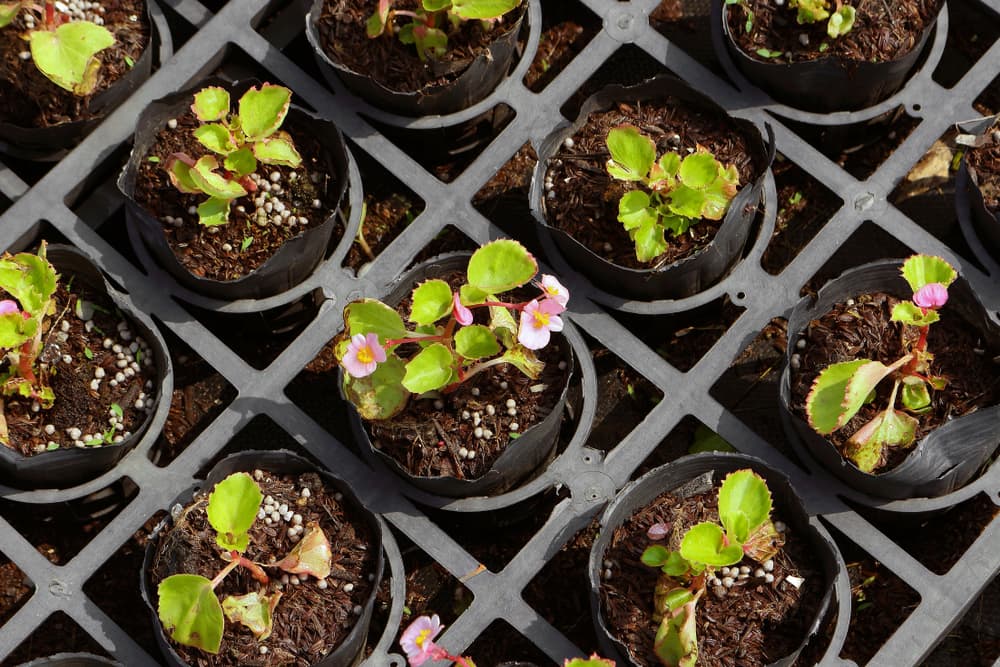Propagating Begonia: Taking Cuttings For Tuberous, Fibrous-Rooted, Rhizomatous Types

ANNUALS > BEGONIA > PROPAGATION

Elizabeth is a Permaculture Garden Designer, Sustainability Consultant and Professional Writer, working as an advocate for positive change. She graduated from the University of St. Andrews with an MA in English and Philosophy and obtained a Diploma in Applied Permaculture Design from the Permaculture Association.
Reviewed By DAN ORI

Dan has over 27 years’ under his belt caring for plants and gardens. Working as a Horticultural Instructor and Consultant, he draws on a diverse range of experience that includes working as a Head Gardener, Tree Surgeon, Garden Centre Trouble Shooter, and writer of academic papers. Dan has a Level 3 Diploma in Horticulture and is currently a candidate for the RHS’s most prestigious award – The Master of Horticulture.
IN THIS GUIDE
Fibrous-rooted and tuberous Begonias are propagated by stem or leaf cuttings; however, the process is easier and more straightforward with fibrous-rooted Begonias.
Within the fibrous-rooted class it is easier to propagate cane-stemmed varieties by stem cuttings, and semperflorens or wax varieties through leaf cuttings.
| Difficulty | Moderate to Hard |
| Equipment Required | Gardening knife, cuttings, compost mix, pot or module tray, propagator |
| When To Take Cuttings | April, May, June |
Whichever method you choose, use a sharp pair of secateurs which has been sterilised with rubbing alcohol.
When To Propagate Begonia

When to take and propagate begonia cuttings depends on the type you’re growing:
- Take stem cuttings of tuberous Begonias and some double-flowered cultivars of Begonia semperflorens outdoors Begonias in April.
- Take stem cuttings of fibrous-rooted and cane-stemmed houseplant Begonias in April.
- Take leaf cuttings of Begonia rex hybrids and other indoors types in May or June.
- Take basal cuttings of Semi-tuberous houseplant Begonias in Spring.
No matter which method you use, adding rooting hormone is usually a good idea.
Check out the steps for propagating each type below.
Propagating Tuberous (Outdoors) Begonia

Tuberous Begonias grown outdoors in the ground or in containers can be propagated by stem cuttings taken in April.
Take 10cm long cuttings of stem with a heel (section of the tuber) attached.
Place these in a mix of peat-free compost and sand, and provide bottom heat of 18-21°C.
Propagating Fibrous Rooted (Outdoors) Begonia

Double-flowered types of B. semperflorens are also usually propagated from stem cuttings.
After overwintering the plants in a cool location, in April, take 7.5-10cm long cuttings.
Place in a suitable medium, as above, and, again, provide bottom heat of 18-21°C.
Propagating Fibrous-Rooted & Cane-Stemmed Begonia

Also in April, take 7-10cm long stem cuttings of fibrous-rooted or cane-stemmed Begonias.
These should be inserted in a suitable medium as above, and provided with bottom heat of 18-21°C.
Propagating Rhizomatous Begonia

If you are growing rhizomatous Begonias indoors, you may need to take longer stem cuttings because you should be sure to include a leaf node at the base.
Certain rhizomatous types, like B. rex hybrids and cultivars, are also frequently propagated from leaf cuttings, taken in May or June.
Take a newly matured leaf, cut off the stalk, cut carefully through major veins, spacing cuts around 2.5cm apart.
Place and peg the leaf onto a seed tray of sandy cuttings compost.
Water well and keep at 18-24°C, with good humidity, to wait for plantlets to form from cut points.
Rex Begonias

In addition to the leaf-cutting method, Rex Begonia varieties are often propagated by a specialised method.
Select a leaf that has just matured.
From its bottom or lower surface, make a few small incisions along the veins, using a disinfected sharp blade.
Place the leaf, lower side down, on compost and peg it or put light weights on the leaf so that it stays in tight contact with the soil.
Keep it in bright sunlight (but not under a hot sun) and water it well.
Rootlets will emerge from the cuts in the vein.
While almost all Begonias can be propagated by stem or leaf cuttings, rhizomatous varieties are also propagated by division.
Propagating Semi-Tuberous (Indoors) Begonia

Propagating semi-tuberous Begonia from stem cuttings is a little more challenging, though this is the most common method employed to obtain these plants for the following year.
After they have flowered, allow the plants to rest by reducing the temperature to 7°C and reducing water but not inducing complete drought.
Maintain this rest state for around 6 weeks.
After the end of this period, prune back to within 15cm of the base, and raise the temperature to 10-13°C, to stimulate new growth.
When the new growth is around 5cm long, take basal cuttings of these new shoots and root them at 18-22°C.
Keep them lightly shaded until they have rooted well, then pot on.
